High-resolution wavelength-dispersive spectrometer for low-energy X-rays.
For energies above a few hundred eV this is conveniently done by energy dispersive X-ray emission spectroscopy (EDX) using an energy dispersive detector. An alternative method is wavelength dispersive X-ray emission spectroscopy (WDX), which reaches a higher resolution but requires to scan the energy range of interest.
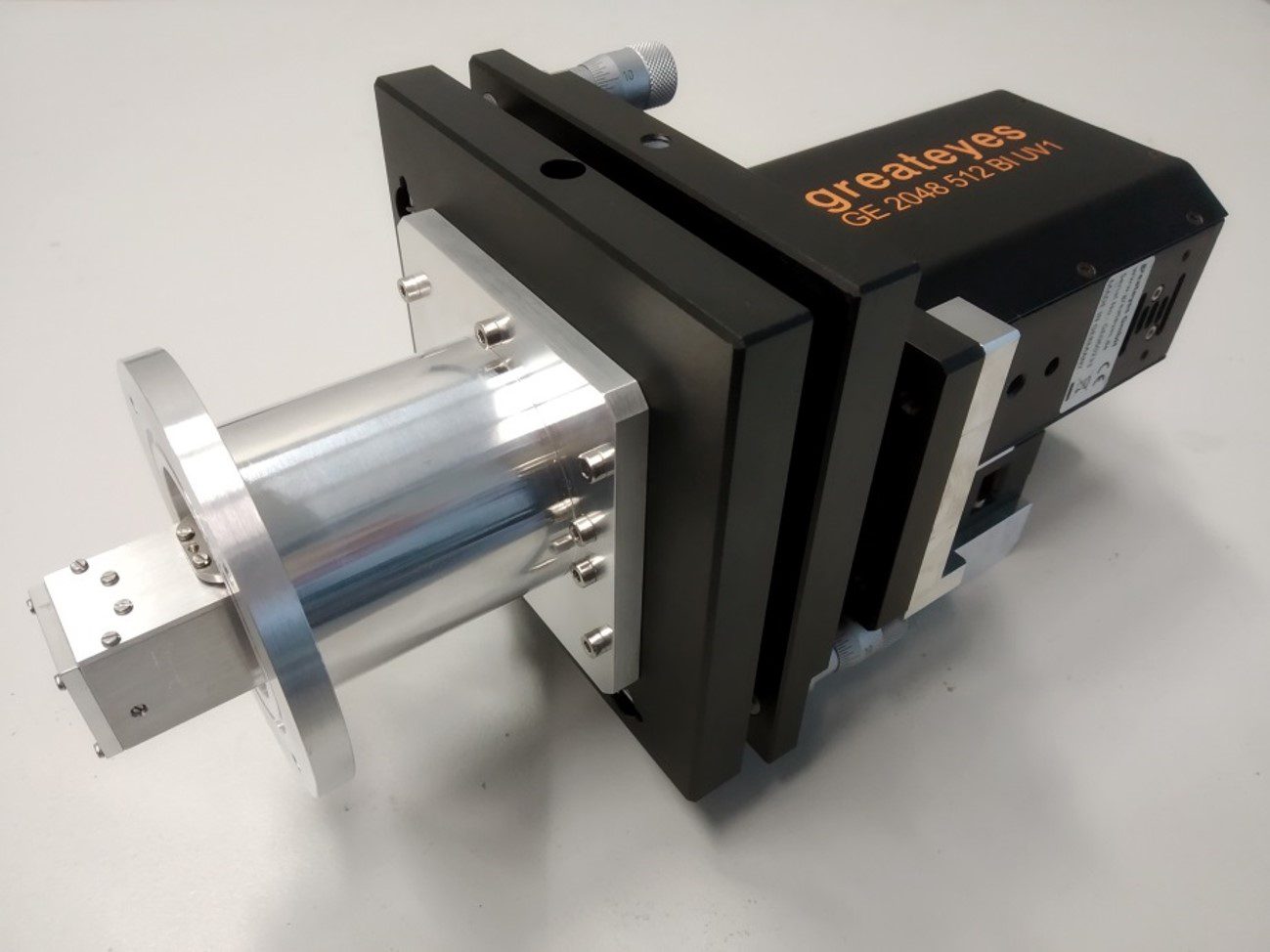
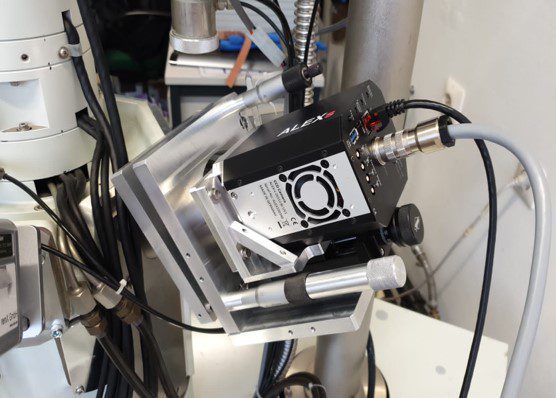
In contrast, a novel parallel wavelength-dispersive soft X-ray spectrometer (WDSX) is offered by NOB Nano Optics Berlin GmbH. It is based on a Fresnel reflection zone plate (RZP), which simultaneously acts as a reflective, dispersive, and focusing element.
Both EDX and WDX methods show a poor resolution of many eV below 300 eV. In this region the K lines of light elements like Li, B and C can be found. Measuring them with a high resolution allows to characterize the chemical shift in the energy of the photons due to the chemical bonding of the atom which amount to a few eV. The WDSX-300 has an energy resolution of 0.3 eV at 72 eV.
The efficiency of the WDSX-300 is one order of magnitude higher than that of existing grating spectrometers. In addition, it displays a high energy resolving power in a chosen energy range and a high angular acceptance. The optical imaging is based on a single optical element, an RZP on a spherical substrate.
As an example, we feature a WDSX-300 specialized for the detection of light elements, covering the energy range of 35-110 eV. It covers particularly the lithium K lines for the pure element as well as its chemical compounds and thus allows analyzing the fine structures of the energy states of the binding electron.
This is just an example. The energy range of the spectrometer can be customized within the whole soft and hard X-ray region up to a few keV by adapting the reflection zone plate to the requirements of the user.
Optical concept of the spectrometer
The optical layout of the WDSX-300 spectrometer consists of only one optical element – a reflection zone plate on a spherical substrate.
The divergent beam emitted by the sample is dispersed and focused in meridional direction by the RZP. The 1st order of the RZP provides a spectrally resolved line pattern on the 2-dimensional CCD detector. The RZP has a special lamellar groove profile which provides better high order suppression of contaminating materials such as carbon and oxygen. The optical geometry with 1:1 magnification minimizes spherical aberrations and maximizes the energy range of high-resolution flat field spectral registration.
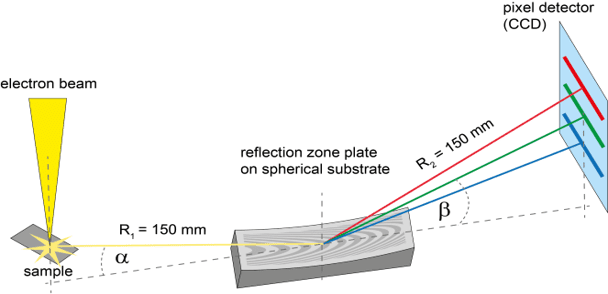
Optical layout of the WDSX spectrometer system.
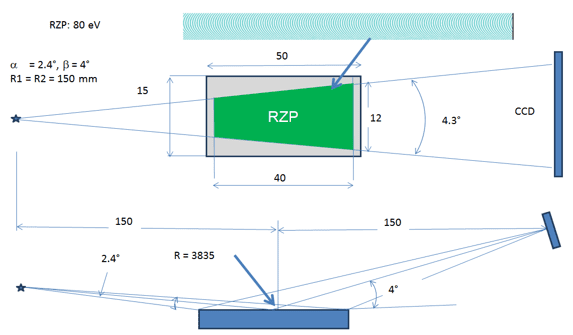
Optical Element
We use an RZP on a spherical substrate, based on the theoretical description given in [1]. With this set up one considerably benefits from the enlarged energy range across which the diffracted beam is sharply focused (Fig. 2). The typical range symmetrically extends around the design energy from the lowest energy to about three times this value.
Parameters of the RZP
- Design energy (eV) : 80 eV
- Energy range (eV) : 35 – 110
- Lamellar groove profile (nm) : 81
- First focal distance R1 (mm) : 150
- Second focal distance R2 (mm) : 150
- Substrate radius of curvature (m) : 3.835
- Grazing angles input/ouput : α = 2.4°, β = 4°
- Meridional line density (l/mm) : 83.83 – 100.59 – 124.48
- Angular aperture (mrad) : 11 (meridional) x 70.5 (sagittal)
- Coating: carbon
Spatial / angular range for the RZP alignment
- Translation along the optical axis : ± 5 mm
- Translation accuracy : ± 50 µm
- Angular tilt range perpendicular to optical axis : ± 5 arc deg
- Angular alignment accuracy : ± 10 arc sec
The mechanical system of the spectrometer consists of a 3-D manual goniometer for the alignment of the WDSX relative to the source. The CCD detector and the RZP are fixed on the same frame.
Optical performance
Energy resolution
The energy resolution was measured at the L- edge of pure aluminum metal, which is usually used to determine the resolution of spectrometers. The results of the measurements are shown in Figure 3.
The spectral width of △E = 0,3 eV was measured between the intensity levels of 25% and 75% of the maximum.
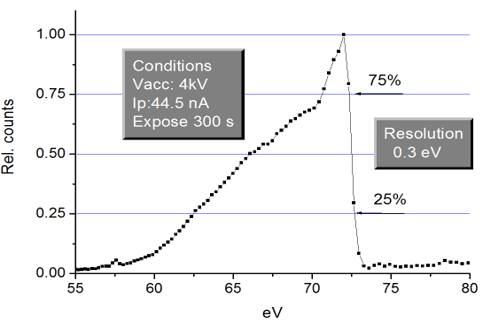
Al L spectrum, showing the Fermi edge. Experimental results.
The efficiency of the complete spectrometer depends on many factors, such as the quality of the substrate, the RZP diffraction efficiency, the CCD quantum efficiency etc.
The efficiencies of the RZP were calculated with the program REFLEX and optimized for the maximum reflectivity at the design energies of the RZP. The theoretical efficiency of the RZP, is calculated for a carbon coating and a 2 nm thick natural contamination CO layer on top of the carbon coating.
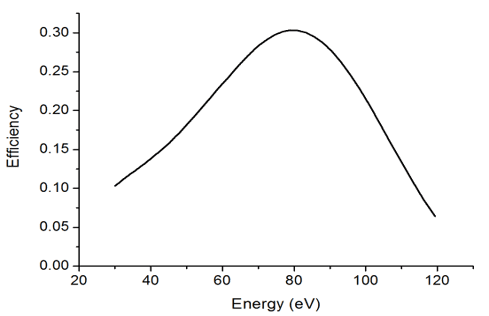
Diffraction efficiency of the RZP, calculated for a single RZP.
Compatibility with e-beam instrumentation
With the proper adapter flange WDSX-300 is compatible (has been tested) with ZEISS DSM 942, Zeiss EVO 40, JEOL 6400, JEOL 733 and CAMECA SX 100. It can be fitted to most of the other devices by a customized adapter flange.
Software
The spectrometer delivers a calibrated energy spectrum of the sample emission in ASCII format. The main steps of the energy calibration, which rely on the known energies of peaks in the spectrum, are accessable to the user.
General information
The radiation is detected by a CCD camera for low light level imaging with enhanced sensitivity for soft x-rays. The CCD camera has a USB interface.
The software reads the CCD data and delivers a calibrated energy spectrum available to the user.
The WDSX does not contain consumables.
The spectrometer is less than 50 cm long and weighs less than 15 kg.
Specifications
The performance of the WDSX-300 for the analysis of light elements is characterized by the following parameters:
| Energy range: | Flat field registration in a core range of 35 – 110 eV |
| Energy resolution at Al L edge (72 eV): | △E ~ 0,3 eV |
| Acceptance: | Full beam profile sagittal: 70.5 mrad, meridional: 11 mrad |
| Efficiency: | 10 % absolute efficiency guaranteed in the energy range 40-60 eV and expected in the energy range 35 – 110 eV |
| Detector: | X-ray CCD 2048 x 512 pixel with the size of 13.5 μm x 13.5 μm. |
